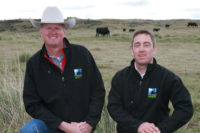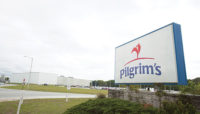Team-driven Turnaround
Tyson Foods successfully navigated the recession by following a tried-and-true strategy that kept its team focused sharply on eliminating inefficiencies and re-dedicating itself to its customers.

Photos by Jeff Peak, Tyson Foods


Source: Tyson Foods press reeleases; Charles Schwab & Co. website.

Photos by Jeff Peak, Tyson Foods

Photos by Jeff Peak, Tyson Foods

Tyson Foods’ team at its Sherman, Texas, case-ready plant has done its fair share of helping the company turn itself around over the years, through its focus on efficiency and corporate culture. Representing the facility are (front row, left to right) Pete Baker, industrial engineer; Mike Gerleman, complex manager; Bill McKeeman, operations manager; (back, left to right) Dustin Kratochvil, plant engineer; Rita Huske, complex H.R. manager; Yvette Weaver, asst. operations manager; Wayne Grove,material handling superintendent; and Tom Sharp, plant quality assurance manager.
Photos by Jeff Peak, Tyson Foods

Team members at Tyson’s Sherman, Texas, case-ready plant sort through a variety of fresh pork cuts traveling by them on a conveyor, and pack them onto pre-padded and labeled trays, each employee guided by detailed customer specifications.
Photos by Jeff Peak, Tyson Foods

Bill McKeeman (left), operations manager for the Sherman facility, and Andy Hanacek, editor-in-chief of The National Provisioner, discuss the different specifications and technologies that the team uses to efficiently minimize waste during production of boneless fresh pork items.
Photos by Jeff Peak, Tyson Foods

Palletized cases of fresh, case-ready beef products are about to be loaded and removed from the sorting room at the Sherman plant.
Photos by Jeff Peak, Tyson Foods
Photos by Jeff Peak, Tyson Foods

Charlie Stone (right),general foreman at the Sherman plant, explains the facility’s labeling and packaging capabilities to Hanacek.
Photos by Jeff Peak, Tyson Foods













 "Don [Tyson] meant a lot to so many of us, and we’ve learned so much about what to do from him. Maybe in a lot of our hearts, out of respect for him, there is a desire to carry on the legacy of taking care of our customers. Don taught us that this business is a people business, and our job as a leadership team is to take care of our team members and trust them with the awesome responsibility of taking care of our customers. And you know what, they do a great job at doing just that. I think [his passing] brought back pride and heritage in what Don built, and then a desire to really follow through his legacy and that heartfelt desire to keep up the good work, doing what we’re doing and really making a difference for folks. He taught us well, and we’re still getting it done.”
"Don [Tyson] meant a lot to so many of us, and we’ve learned so much about what to do from him. Maybe in a lot of our hearts, out of respect for him, there is a desire to carry on the legacy of taking care of our customers. Don taught us that this business is a people business, and our job as a leadership team is to take care of our team members and trust them with the awesome responsibility of taking care of our customers. And you know what, they do a great job at doing just that. I think [his passing] brought back pride and heritage in what Don built, and then a desire to really follow through his legacy and that heartfelt desire to keep up the good work, doing what we’re doing and really making a difference for folks. He taught us well, and we’re still getting it done.”


















